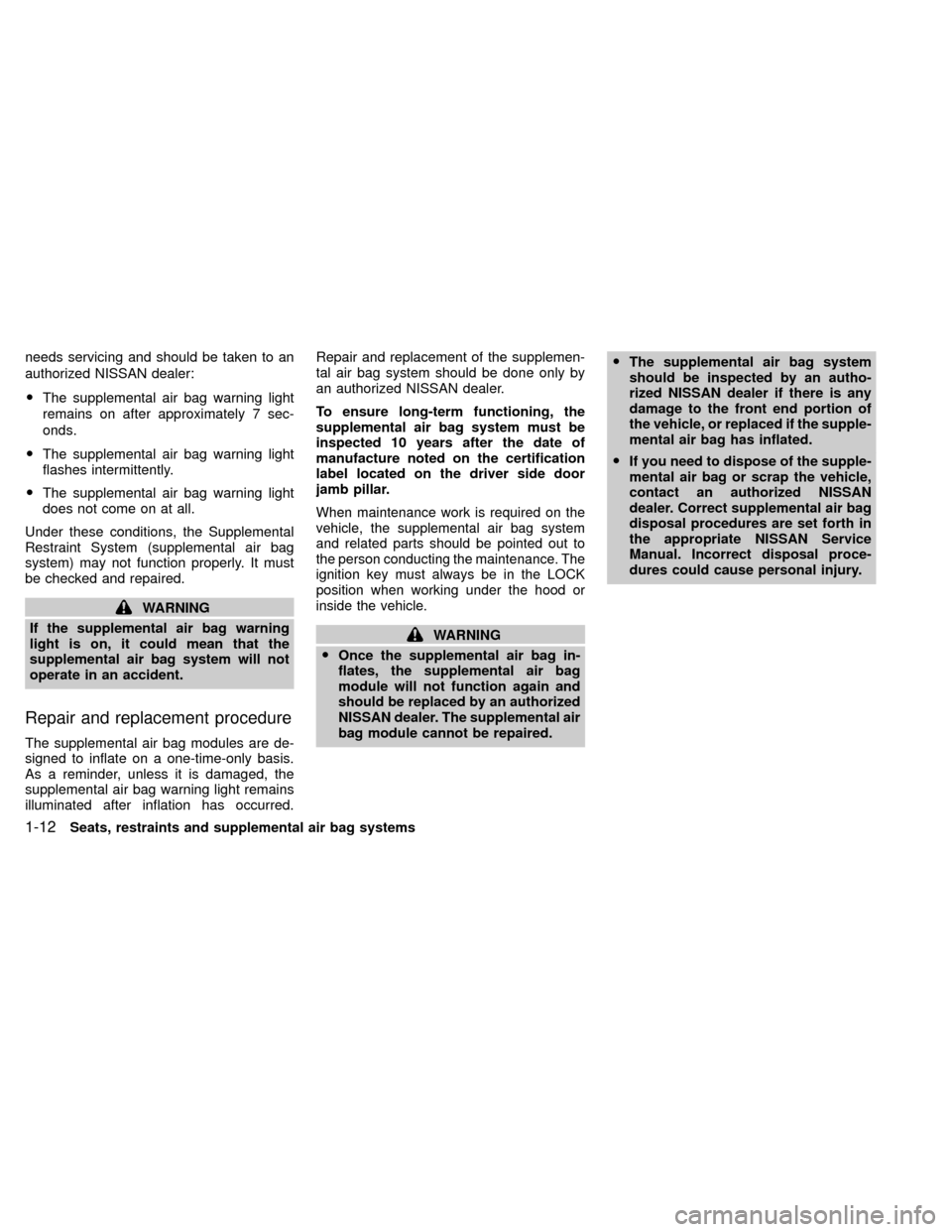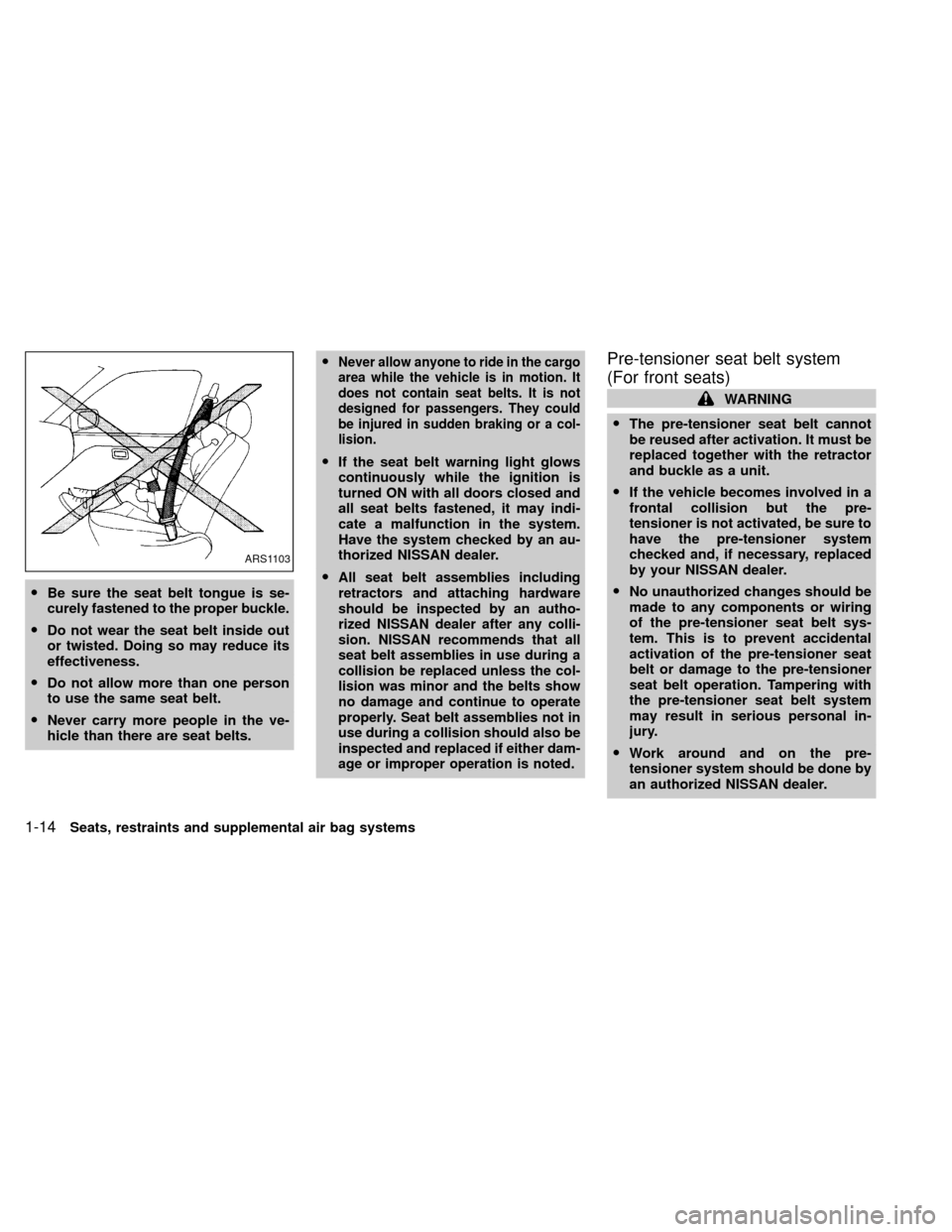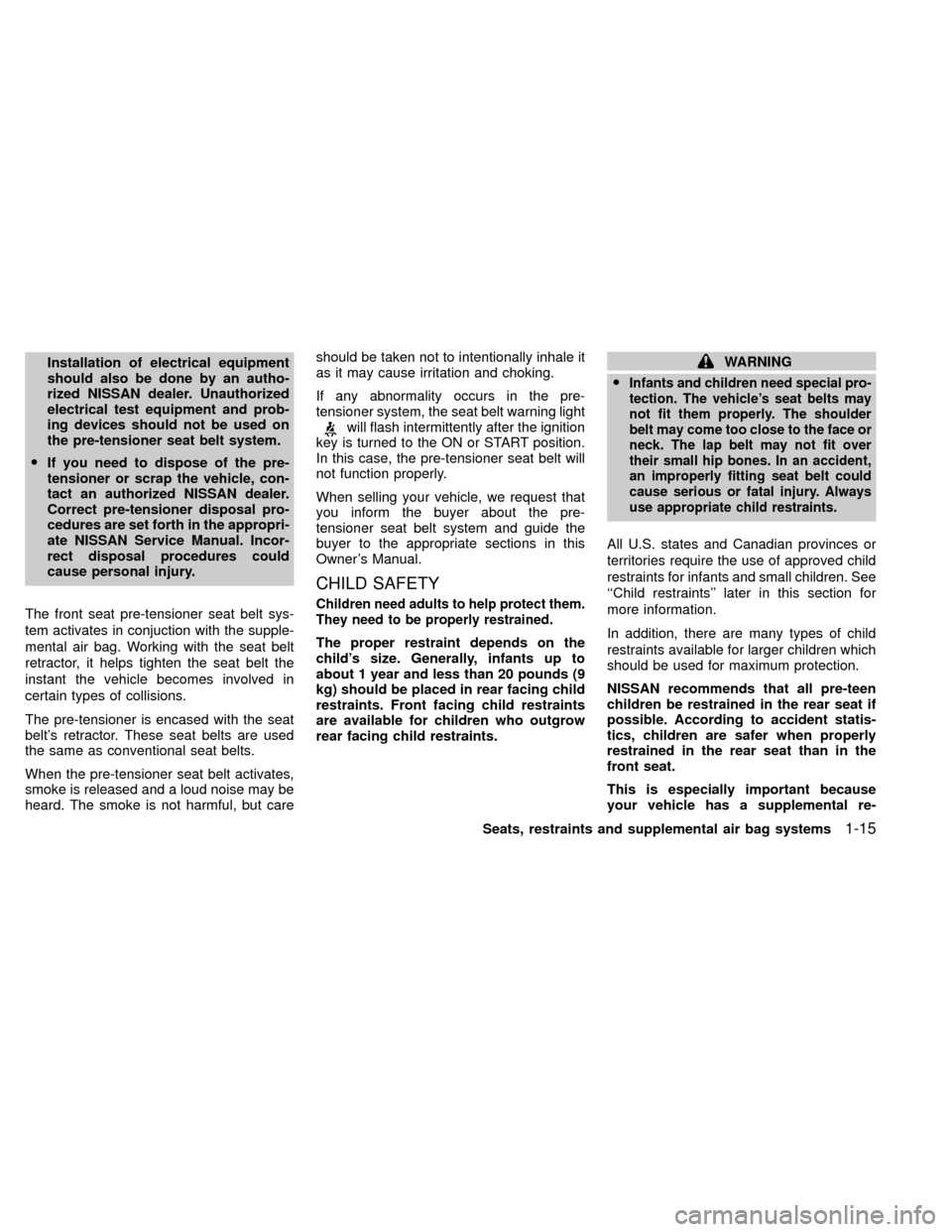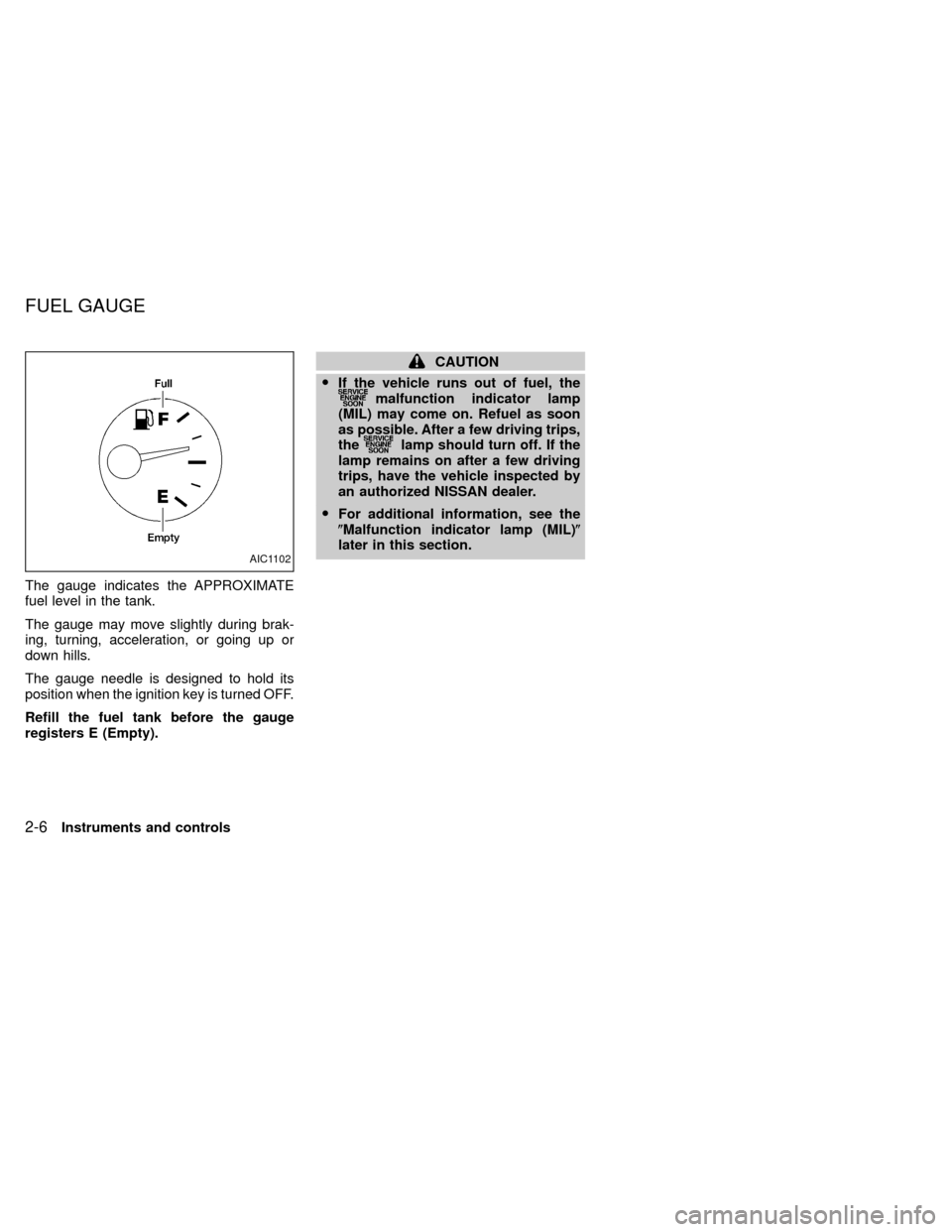2000 NISSAN XTERRA light
[x] Cancel search: lightPage 8 of 263

1 Seats, restraints and supplemental air
bag systems
Front bucket seats..................................................1-2
Seat adjustment .....................................................1-2
Head restraints .......................................................1-3
Rear seat ................................................................1-4
Supplemental restraint system (supplemental
air bag system).......................................................1-6
Supplemental air bag system.................................1-9
Warning labels...................................................... 1-11
Supplemental air bag warning light...................... 1-11
Seat belts .............................................................1-13
Precautions on seat belt usage ...........................1-13
Child safety...........................................................1-15
Pregnant women ..................................................1-16
Injured persons ....................................................1-16
Three-point type with retractor .............................1-16Two-point type without retractor (rear center
lap belt).................................................................1-19
Seat belt extenders ..............................................1-21
Seat belt maintenance .........................................1-21
Child restraints .....................................................1-22
Front facing installation at rear seat center
position .................................................................1-24
Rear facing installation at rear seat center
position .................................................................1-25
Front facing installation at rear seat outboard
positions ...............................................................1-26
Rear facing installation at rear seat outboard
positions ...............................................................1-29
Top strap child restraint ........................................1-31
ZX
Page 18 of 263

Warning labels about the supplemental air
bag system are placed in the vehicle as
shown in the illustration.The supplemental air bag warning light,
displaying
in the instrument panel,
monitors the circuits of the supplemental air
bag system. The circuits monitored by the
supplemental air bag warning light are the
diagnosis sensor unit, the supplemental air
bag modules and all related wiring.
When the ignition key is in the ON or START
position, the supplemental air bag warning
light illuminates for about 7 seconds and
then turns off. This means the system is
operational.
If any of the following system conditions
occur, the supplemental air bag system
ARS1229
ARS1230
WARNING LABELS SUPPLEMENTAL AIR BAG
WARNING LIGHT
Seats, restraints and supplemental air bag systems1-11
ZX
Page 19 of 263

needs servicing and should be taken to an
authorized NISSAN dealer:
OThe supplemental air bag warning light
remains on after approximately 7 sec-
onds.
OThe supplemental air bag warning light
flashes intermittently.
OThe supplemental air bag warning light
does not come on at all.
Under these conditions, the Supplemental
Restraint System (supplemental air bag
system) may not function properly. It must
be checked and repaired.
WARNING
If the supplemental air bag warning
light is on, it could mean that the
supplemental air bag system will not
operate in an accident.
Repair and replacement procedure
The supplemental air bag modules are de-
signed to inflate on a one-time-only basis.
As a reminder, unless it is damaged, the
supplemental air bag warning light remains
illuminated after inflation has occurred.Repair and replacement of the supplemen-
tal air bag system should be done only by
an authorized NISSAN dealer.
To ensure long-term functioning, the
supplemental air bag system must be
inspected 10 years after the date of
manufacture noted on the certification
label located on the driver side door
jamb pillar.
When maintenance work is required on the
vehicle, the supplemental air bag system
and related parts should be pointed out to
the person conducting the maintenance. The
ignition key must always be in the LOCK
position when working under the hood or
inside the vehicle.
WARNING
OOnce the supplemental air bag in-
flates, the supplemental air bag
module will not function again and
should be replaced by an authorized
NISSAN dealer. The supplemental air
bag module cannot be repaired.OThe supplemental air bag system
should be inspected by an autho-
rized NISSAN dealer if there is any
damage to the front end portion of
the vehicle, or replaced if the supple-
mental air bag has inflated.
OIf you need to dispose of the supple-
mental air bag or scrap the vehicle,
contact an authorized NISSAN
dealer. Correct supplemental air bag
disposal procedures are set forth in
the appropriate NISSAN Service
Manual. Incorrect disposal proce-
dures could cause personal injury.
1-12Seats, restraints and supplemental air bag systems
ZX
Page 21 of 263

OBe sure the seat belt tongue is se-
curely fastened to the proper buckle.
ODo not wear the seat belt inside out
or twisted. Doing so may reduce its
effectiveness.
ODo not allow more than one person
to use the same seat belt.
ONever carry more people in the ve-
hicle than there are seat belts.O
Never allow anyone to ride in the cargo
area while the vehicle is in motion. It
does not contain seat belts. It is not
designed for passengers. They could
be injured in sudden braking or a col-
lision.
OIf the seat belt warning light glows
continuously while the ignition is
turned ON with all doors closed and
all seat belts fastened, it may indi-
cate a malfunction in the system.
Have the system checked by an au-
thorized NISSAN dealer.
O
All seat belt assemblies including
retractors and attaching hardware
should be inspected by an autho-
rized NISSAN dealer after any colli-
sion. NISSAN recommends that all
seat belt assemblies in use during a
collision be replaced unless the col-
lision was minor and the belts show
no damage and continue to operate
properly. Seat belt assemblies not in
use during a collision should also be
inspected and replaced if either dam-
age or improper operation is noted.
Pre-tensioner seat belt system
(For front seats)
WARNING
OThe pre-tensioner seat belt cannot
be reused after activation. It must be
replaced together with the retractor
and buckle as a unit.
OIf the vehicle becomes involved in a
frontal collision but the pre-
tensioner is not activated, be sure to
have the pre-tensioner system
checked and, if necessary, replaced
by your NISSAN dealer.
ONo unauthorized changes should be
made to any components or wiring
of the pre-tensioner seat belt sys-
tem. This is to prevent accidental
activation of the pre-tensioner seat
belt or damage to the pre-tensioner
seat belt operation. Tampering with
the pre-tensioner seat belt system
may result in serious personal in-
jury.
OWork around and on the pre-
tensioner system should be done by
an authorized NISSAN dealer.
ARS1103
1-14Seats, restraints and supplemental air bag systems
ZX
Page 22 of 263

Installation of electrical equipment
should also be done by an autho-
rized NISSAN dealer. Unauthorized
electrical test equipment and prob-
ing devices should not be used on
the pre-tensioner seat belt system.
OIf you need to dispose of the pre-
tensioner or scrap the vehicle, con-
tact an authorized NISSAN dealer.
Correct pre-tensioner disposal pro-
cedures are set forth in the appropri-
ate NISSAN Service Manual. Incor-
rect disposal procedures could
cause personal injury.
The front seat pre-tensioner seat belt sys-
tem activates in conjuction with the supple-
mental air bag. Working with the seat belt
retractor, it helps tighten the seat belt the
instant the vehicle becomes involved in
certain types of collisions.
The pre-tensioner is encased with the seat
belt's retractor. These seat belts are used
the same as conventional seat belts.
When the pre-tensioner seat belt activates,
smoke is released and a loud noise may be
heard. The smoke is not harmful, but careshould be taken not to intentionally inhale it
as it may cause irritation and choking.
If any abnormality occurs in the pre-
tensioner system, the seat belt warning light
will flash intermittently after the ignition
key is turned to the ON or START position.
In this case, the pre-tensioner seat belt will
not function properly.
When selling your vehicle, we request that
you inform the buyer about the pre-
tensioner seat belt system and guide the
buyer to the appropriate sections in this
Owner's Manual.
CHILD SAFETY
Children need adults to help protect them.
They need to be properly restrained.
The proper restraint depends on the
child's size. Generally, infants up to
about 1 year and less than 20 pounds (9
kg) should be placed in rear facing child
restraints. Front facing child restraints
are available for children who outgrow
rear facing child restraints.
WARNING
O
Infants and children need special pro-
tection. The vehicle's seat belts may
not fit them properly. The shoulder
belt may come too close to the face or
neck. The lap belt may not fit over
their small hip bones. In an accident,
an improperly fitting seat belt could
cause serious or fatal injury. Always
use appropriate child restraints.
All U.S. states and Canadian provinces or
territories require the use of approved child
restraints for infants and small children. See
``Child restraints'' later in this section for
more information.
In addition, there are many types of child
restraints available for larger children which
should be used for maximum protection.
NISSAN recommends that all pre-teen
children be restrained in the rear seat if
possible. According to accident statis-
tics, children are safer when properly
restrained in the rear seat than in the
front seat.
This is especially important because
your vehicle has a supplemental re-
Seats, restraints and supplemental air bag systems
1-15
ZX
Page 41 of 263

3. Pull on the shoulder belt until all of the
belt is fully extended. At this time, the belt
retractor is in the automatic locking mode
(child restraint mode). It reverts back to
emergency locking mode when the belt is
fully retracted.4. Allow the seat belt to retract slightly. Pull
up on the seat belt to remove any slack in
the belt.5. Before placing the child in the child re-
straint, use force to tilt the child restraint
from side to side, and tug it forward to
make sure it is securely held in place.
6.
Check that the retractor is in the automatic
locking mode by trying to pull more seat
belt out of the retractor. If you cannot pull
any more seat belt webbing out of the
retractor, the retractor is in the automatic
locking mode.
7. Check to make sure the child restraint is
properly secured prior to each use. If the
seat belt is not locked, repeat steps 3
through 6.
ARS1034ARS1074ARS1079
1-34Seats, restraints and supplemental air bag systems
ZX
Page 44 of 263

2 Instruments and controls
Meters and gauges ................................................2-2
Speedometer and odometer ..................................2-3
Tachometer .............................................................2-5
Engine coolant temperature gauge........................2-5
Fuel gauge .............................................................2-6
Warning/indicator lights and chimes ......................2-7
Theft warning (if so equipped) .............................2-12
Headlight and turn signal switch ..........................2-14
Daytime running light system (Canada only) .......2-14
Front fog light switch (if so equipped)..................2-15
Windshield wiper and washer switch ...................2-16
Rear window wiper and washer switch
(if so equipped) ....................................................2-17
Instrument brightness control ...............................2-17
Rear window defogger switch ..............................2-18
Hazard warning flasher switch .............................2-18Cigarette lighter (accessory) and ash tray ...........2-19
Power point (if so equipped) ................................2-19
Storage compartment ...........................................2-20
Tie down hooks ....................................................2-21
Tonneau cover ......................................................2-22
Cup holder ............................................................2-22
Map pockets .........................................................2-23
Dome light ............................................................2-24
Map lights (if so equipped)...................................2-24
Illuminated entry system ......................................2-25
Manual windows ...................................................2-25
Power windows (if so equipped) ..........................2-25
Automatic power window switch ..........................2-27
Skyroof (if so equipped) .......................................2-27
ZX
Page 49 of 263

The gauge indicates the APPROXIMATE
fuel level in the tank.
The gauge may move slightly during brak-
ing, turning, acceleration, or going up or
down hills.
The gauge needle is designed to hold its
position when the ignition key is turned OFF.
Refill the fuel tank before the gauge
registers E (Empty).
CAUTION
OIf the vehicle runs out of fuel, the
malfunction indicator lamp
(MIL) may come on. Refuel as soon
as possible. After a few driving trips,
the
lamp should turn off. If the
lamp remains on after a few driving
trips, have the vehicle inspected by
an authorized NISSAN dealer.
OFor additional information, see the
(Malfunction indicator lamp (MIL)(
later in this section.
AIC1102
FUEL GAUGE
2-6Instruments and controls
ZX